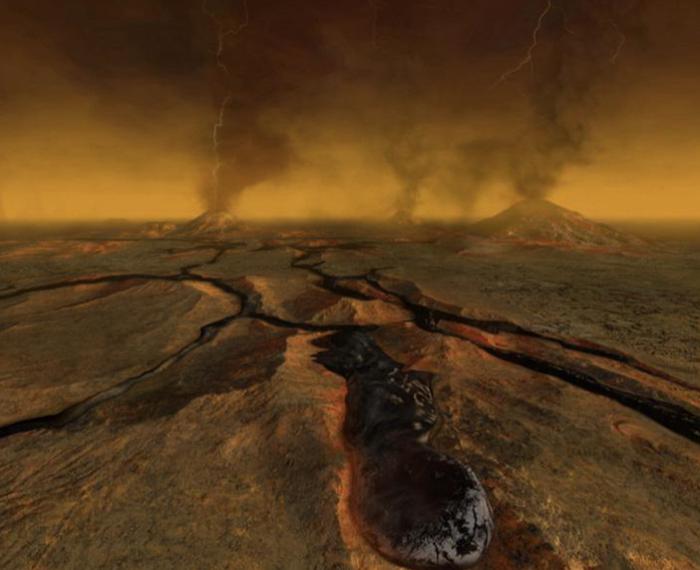
Subscribe to Pittwire Today
Get the most interesting and important stories from the University of Pittsburgh.Pitt findings point to lava as a source of Venus’ CO2-rich atmosphere

“Earth’s twin” isn’t exactly like our home planet. Venus is known for being hot, with clouds of sulfuric acid and a deadly-to-humans carbon dioxide-rich atmosphere. It is often held up as a warning: This is what the greenhouse effect can do to a planet.
As far as anyone knows, however, there was no Venusian industrial revolution. So where did the CO2 come from? It’s long been a debate among planetary scientists. Maybe there was a global volcanic resurfacing event; maybe it’s the cumulative result of many small-scale regional processes. Could it have been caused by an asteroid impact?
A recent study led by Arizona State University and including a Pitt collaborator points to a different source. Lava flows — the same lava that carved the longest volcanic channel in the solar system — may have released enough carbon dioxide to account for the change in Venus’ atmosphere, which was likely once much more like our own.
“One theory has been that the change in Venus’ atmosphere was volcanically related to some extent, but there hasn’t been a lot of evidence to support it,” said Ian Flynn, research assistant professor in the Kenneth P. Dietrich School of Arts and Sciences’ Department of Geology and Environmental Science and a member of the Pitt Space Initiative. “This is a big step forward for our understanding of Venus.”
The Arizona State research team, led by Allyson Trussell, initially set out to solve the mystery of how Venus’ channels (or canali, as they are called in the field) formed. Specifically, they were trying to determine the composition of the lava that carved the canali found around the planet’s surface.
“The longest channel is about 6,800 kilometers (4,225 miles) in length,” Flynn said. “They look like river channels and they are much longer than anything else we’ve seen in the solar system.”
Researchers haven’t been able to agree on what carved out these channels. Maybe it was some exotic material akin to the extremely high-viscosity magma, known as komatiite, that erupted from prehistoric volcanoes? Many believed the channels were made by a familiar basaltic composition: lava, which is found at most eruption sites on Earth.
But there is one site on present-day Earth — Ol Doinyo Lengai volcano in Uganda — where the lava is not what most people are familiar with. It bubbles out of craters and flows downhill like water. In the ’90s, a group of researchers proposed the lava on Venus might be like that low-viscosity lava. For decades, no one could say for sure.
So many questions remain about the interior of Venus because its dense carbon dioxide-rich atmosphere is difficult to penetrate from above, and its extreme environment destroys equipment in just a couple of hours.
“We have to primarily rely on datasets from NASA’s Magellan mission, in the 1990s,” Flynn said. But there’s another way to try to understand the physical processes on another planet. “We haven’t had new data from satellites on Venus, but computer modelling has gotten better.”
Modeling lava flows is Flynn’s area of expertise.
He shared that expertise with the Arizona State team, working to verify their initial findings: The channels were most likely made by low-viscosity lava flows, similar to the lavas observed at Ol Doinyo Lengai.
As lava cools, it “outgasses,” or releases some of its gas into the environment. Lava high in carbon dioxide, called carbonatite lava, outgasses carbon dioxide.
“So we worked out how much CO2 these lava flows would outgas," Flynn said. “The modeling results we got indicate they could have outgassed the modern carbon dioxide-rich atmosphere on Venus.”
If this is how Venus came to have its atmosphere, then these findings have done more than simply account for one of planetary science’s biggest mysteries — it may also help uncover mysteries in solar systems we haven’t yet discovered
New scientific missions, such as the James Webb Space Telescope, and new techniques have led to researchers finding more planets outside of our system, but there are limits to what we can directly observe about their environments. One way to get a general idea is to use known planets as analogs.
Knowing Venus wasn’t destined to have the atmosphere it does simply by virtue of its position in our solar system expands the range in which researchers can expect to find habitable planets in other systems.
As the team writes in their paper, not all planets in the “Venus Zone” will necessarily be “hellish wastelands.” Ideally, new data from planned missions to Venus, including VERITAS, DAVINCI and EnVision, will help confirm this study’s results and provide further insight into how the planet evolved.
Rendering by Hernán Cañellas. Black, turbulent carbonatite flow forms a white crust as the lava solidifies downstream.

